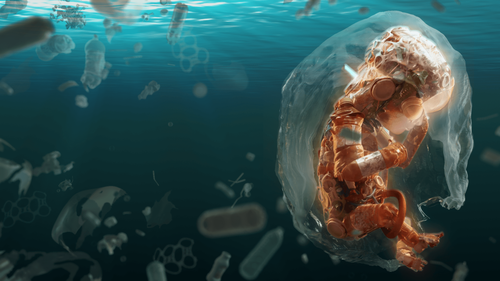First Evidence of Microplastics Found In Human Placentas
For the first time ever, microplastic particles were detected in the placentas of unborn babies, according to researchers who warn these “potentially harmful (plastic) particles is a matter of great concern.”
The study, published in the journal Environment International and titled “Plasticenta: First evidence of microplastics in human placenta,” found microplastics in four placentas of women who had pregnancies and births.
Researchers noted microplastics were found on both the fetal and maternal sides of the placenta and in the membrane within which the fetus develops.
A dozen plastic particles were found in the four placentas, mostly 10 microns in size (0.01mm), meaning they were small enough to travel through the bloodstream and were analyzed to have come originally from packaging paints or polymers and personal care products.
“In total, 12 microplastic fragments (ranging from 5 to 10 μm in size), with spheric or irregular shape were found in 4 placentas (5 in the fetal side, 4 in the maternal side and 3 in the chorioamniotic membranes); all microplastics particles were characterized in terms of morphology and chemical composition. All of them were pigmented; three were identified as stained polypropylene a thermoplastic polymer, while for the other nine it was possible to identify only the pigments, which were all used for man-made coatings, paints, adhesives, plasters, finger paints, polymers and cosmetics and personal care products.”
Antonio Ragusa, director of obstetrics and gynecology at the San Giovanni Calibita Fatebenefratelli hospital in Rome who led the study, told The Guardian that “it’s like having a cyborg baby: no longer composed only of human cells, but a mixture of biological and inorganic entities.”
Researchers concluded:
“Due to the crucial role of the placenta in supporting the fetus’ development and in acting as an interface with the external environment, the presence of potentially harmful plastic particles is a matter of great concern. Further studies need to be performed to assess if the presence of microplastics may trigger immune responses or may lead to the release of toxic contaminants, resulting in harm.”
In August 2019, high levels of microplastics were found in the Alps to the Arctic. Another report has shown these harmful plastics were turning up in human stool.
What’s clear is that the world could have a plastic problem where babies are born pre-polluted. Still, more studies need to be conducted to prove nanoparticles of plastic are dangerous for humans.
Tyler Durden
Tue, 12/22/2020 – 23:05
via ZeroHedge News https://ift.tt/3mN5cpb Tyler Durden
